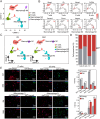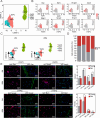Dynamics of single-nuclei transcriptomic profiling of adipose tissue from diverse anatomical locations during mouse aging process
- PMID: 38997312
- PMCID: PMC11245496
- DOI: 10.1038/s41598-024-66918-w
Dynamics of single-nuclei transcriptomic profiling of adipose tissue from diverse anatomical locations during mouse aging process
Abstract
Adipose tissue plays critical roles in an individual's aging process. In this research, we use single-nucleus RNA sequencing to create highly detailed transcriptional maps of subcutaneous adipose tissue and visceral adipose tissue in young and aged mice. We comprehensively identify the various cell types within the white adipose tissue of mice, our study has elucidated seven distinct cell types within this tissue. Further analyses focus on adipocytes, fibro-adipogenic progenitors, and immune cells, revealing age-related declines in the synthetic metabolic activity of adipocytes, diminished immune regulation, and reduced maturation or proliferation of fibroblasts in undifferentiated adipocytes. We confirm the presence of distinct subpopulations of adipocytes, highlighting decreases in adipogenesis subgroups due to aging. Additionally, we uncover a reduction in immune cell subpopulations, driven by age-associated immune system dysregulation. Furthermore, pseudo-time analyses indicate that Adipocyte1 represents the 'nascent' phase of adipocyte development, while Adipocyte2 represents the 'mature' phase. We use cell-cell interaction to explore the age-dependent complexities of the interactions between FAPs and adipocytes, and observed increased expression of the inflammation-related Retn-Tlr4 interaction in older mice, while the anti-inflammatory Angpt1-Tek interaction was only detected in young mice. These transcriptional profiles serve as a valuable resource for understanding the functional genomics underlying metabolic disorders associated with aging in human adipose tissue.
© 2024. The Author(s).
Conflict of interest statement
The authors declare no competing interests.
Figures








Similar articles
-
Identification of functionally distinct fibro-inflammatory and adipogenic stromal subpopulations in visceral adipose tissue of adult mice.Elife. 2018 Sep 28;7:e39636. doi: 10.7554/eLife.39636. Elife. 2018. PMID: 30265241 Free PMC article.
-
Refining the adipose progenitor cell landscape in healthy and obese visceral adipose tissue using single-cell gene expression profiling.Life Sci Alliance. 2019 Nov 25;2(6):e201900561. doi: 10.26508/lsa.201900561. Print 2019 Dec. Life Sci Alliance. 2019. PMID: 31767614 Free PMC article.
-
Single-nucleus RNA sequencing reveals dynamic changes in the microenvironment of visceral adipose tissue and metabolic characteristics after cold exposure.Front Endocrinol (Lausanne). 2025 Mar 24;16:1562431. doi: 10.3389/fendo.2025.1562431. eCollection 2025. Front Endocrinol (Lausanne). 2025. PMID: 40196457 Free PMC article.
-
Adipocyte Heterogeneity Underlying Adipose Tissue Functions.Endocrinology. 2022 Jan 1;163(1):bqab138. doi: 10.1210/endocr/bqab138. Endocrinology. 2022. PMID: 34223880 Free PMC article. Review.
-
Adipose tissue at single-cell resolution.Cell Metab. 2023 Mar 7;35(3):386-413. doi: 10.1016/j.cmet.2023.02.002. Cell Metab. 2023. PMID: 36889280 Free PMC article. Review.
Cited by
-
Developing a novel aging assessment model to uncover heterogeneity in organ aging and screening of aging-related drugs.Genome Med. 2025 Jul 24;17(1):83. doi: 10.1186/s13073-025-01501-0. Genome Med. 2025. PMID: 40708007 Free PMC article.
References
MeSH terms
Grants and funding
LinkOut - more resources
Full Text Sources
Medical
Molecular Biology Databases
Miscellaneous

